N O M T A K
PPS-14 1998.6.11 YOKOHAMA
 |
Thank you ,Professor Inoue for your kind introduction.
Good morning,Ladies and Gentlemen.
It's my great pleasure to speak to you today.
My name is Takao Nomura.
I am responsible for new polymer development at Toyota Motor Corporation.
Today ,I would like to speak concerning Nano Composite which has a good balance of moldability and material properties.
 |
This slide shows the progress in polymer processing.
The improvement of properties and moldability of polymers has been started from the development of polymer blends, as shown in the right and lower zone of this slide.
This is a trial to get both advantages of two blended polymers compatible with each other, but a blend which is too much miscible shows an average property between the two.
A polymer blend which has a performance of an appropriate level is unstable.
Then polymer alloy has been introduced by the dispersion technology of incompatible polymers using compatibilizer.
This is shown in the right and upper zone of the slide. We can control the morphology intentionally and the degree of freedom of polymer design will be increased.
Many kinds of polymer alloy materials have been developed for the practical use recently.
However, there is some limitations in the effect of compatibilizers and I think the recent situation is somewhat toned down.
We have developed successfully the nano composite which is stable thermally as shown in the left and lower zone of the slide.
Polymer crystals are dispersed finely in the solidification process of this nano composite at low temperature, even compatibilizing in nano meter level using the crystallization characteristics of polymers.
I will explain the details hereafter.
 |
This slide shows the relation between flowability and mechanical property of thermoplastics.
Flowability requiring easy melting and flowing, and mechanical properties requiring heat resistance,
creep resistance and impact resistance of the conventional polymer materials are the opposite material properties.
Compromising is the commonsense in the polymer design.
If the good balance can be achieved as shown in the figure,it's pleasant for us.
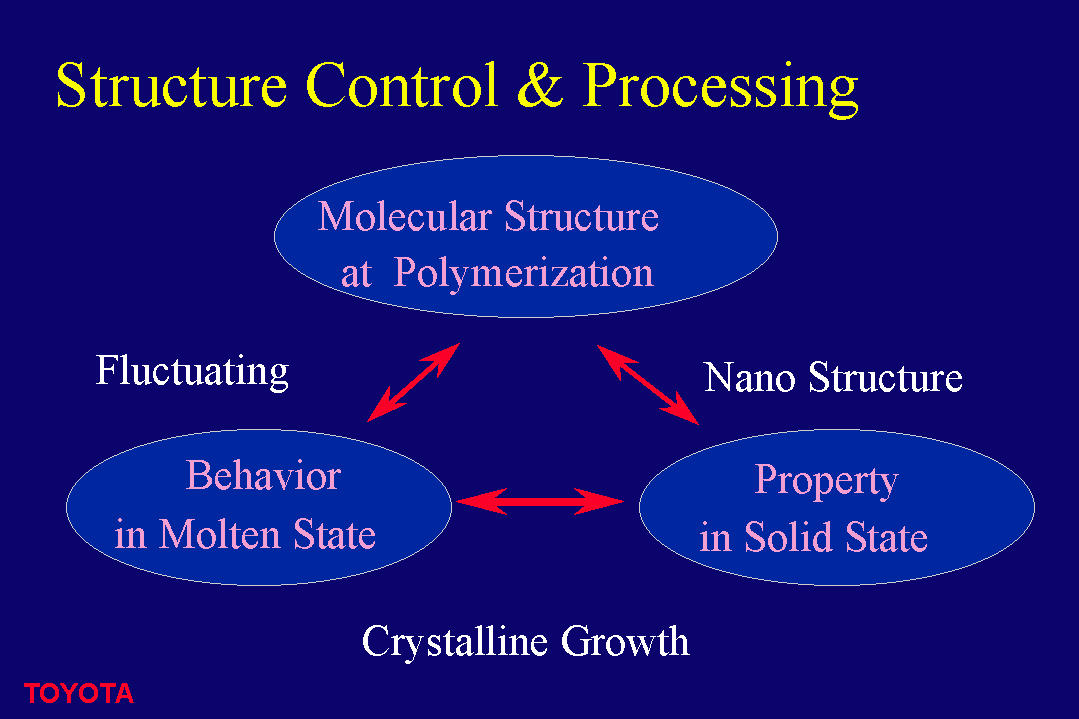 |
This slide shows the relation between the structure control and processing of polymers.
'What kind of polymers should be made' is almost the usual researching pattern with studying material properties in the solid state.
The analysis of their melting state has been studied of course, but it has not been connected directly to the material development because the measurement method was not matured.
We were able to establish our original theory by paying attention to the melting state of polymers and to use it as a tool of the material development resulting in the success.
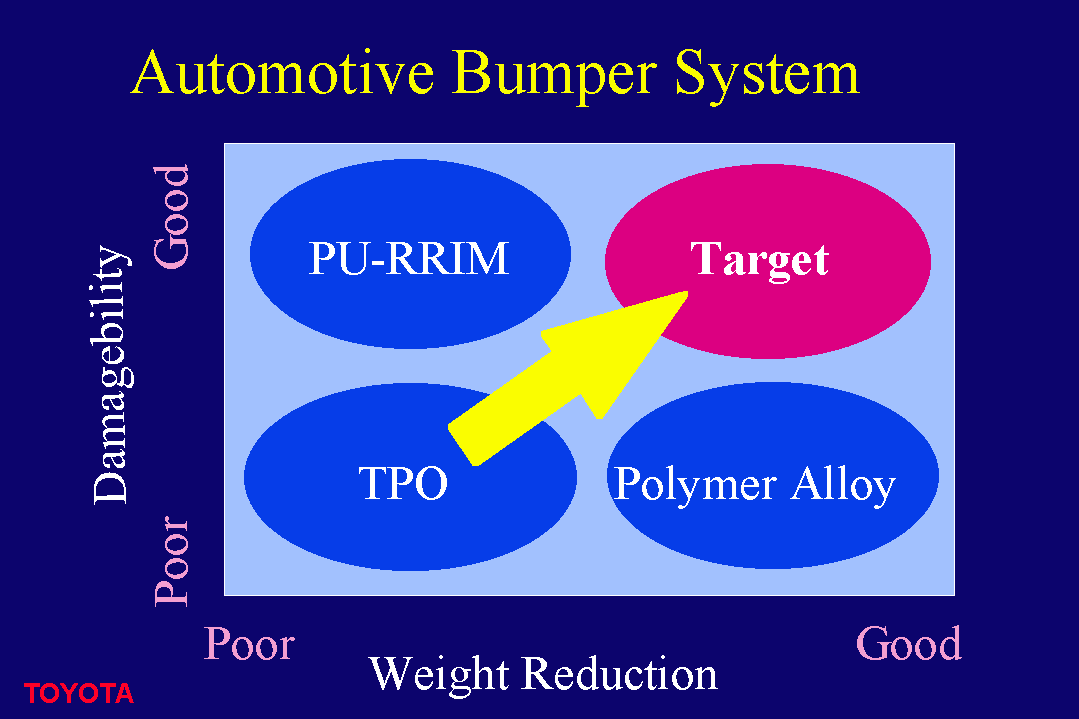 |
I will explain using this slide what is the nano composite we made.
The conventional crystalline polymers have spherulites in micron level in the solid state at low temperature.
The crystalline formation process of polymers are not analyzed fully and it is hard to control that process.
We have proposed the elastomer matrix theory and succeeded in the fine dispersion of polymer crystals in nano meter level in the elastomer phase.
I will introduce you this material which is used in many parts of recent models as the consolidation material for automotive interior applications.
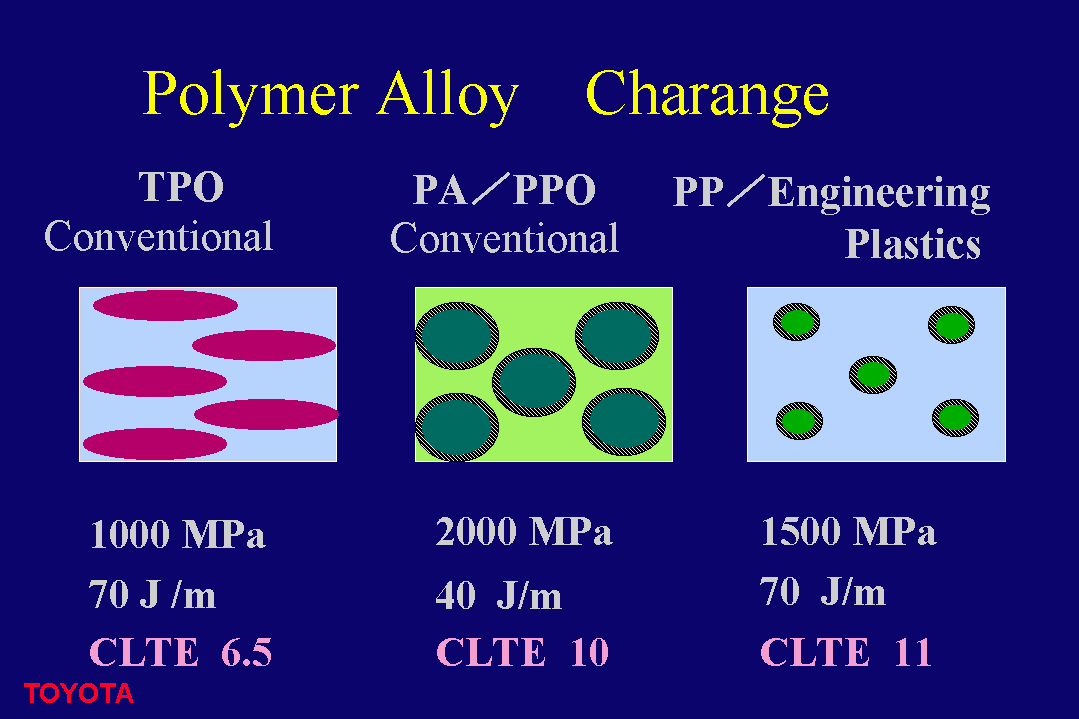 |
This slide shows the material trend of bumpers.
Since TPO gives us the cost advantage but has insufficient material properties and PU-RRIM is not expected for significant weight reduction, we tried to challenge to approach to the target using polymer alloy method which was expected for the technological evolution.
 |
We have started to develop the polymer alloy of PP with engineering plastics, setting PA/PPO as a model material, which is a masterpiece of the polymer alloy.
We had 3 types of polymer alloy materials like PP/PBT.
Mechanical properties was achieved to the targeted values, but unexpectedly the CLTE became double, so we gave up to use those materials for bumpers.
When the elastomer is changed to the engineering plastics with maintaining using PP as a matrix, why the CLTE becomes double?
I could not understand that.
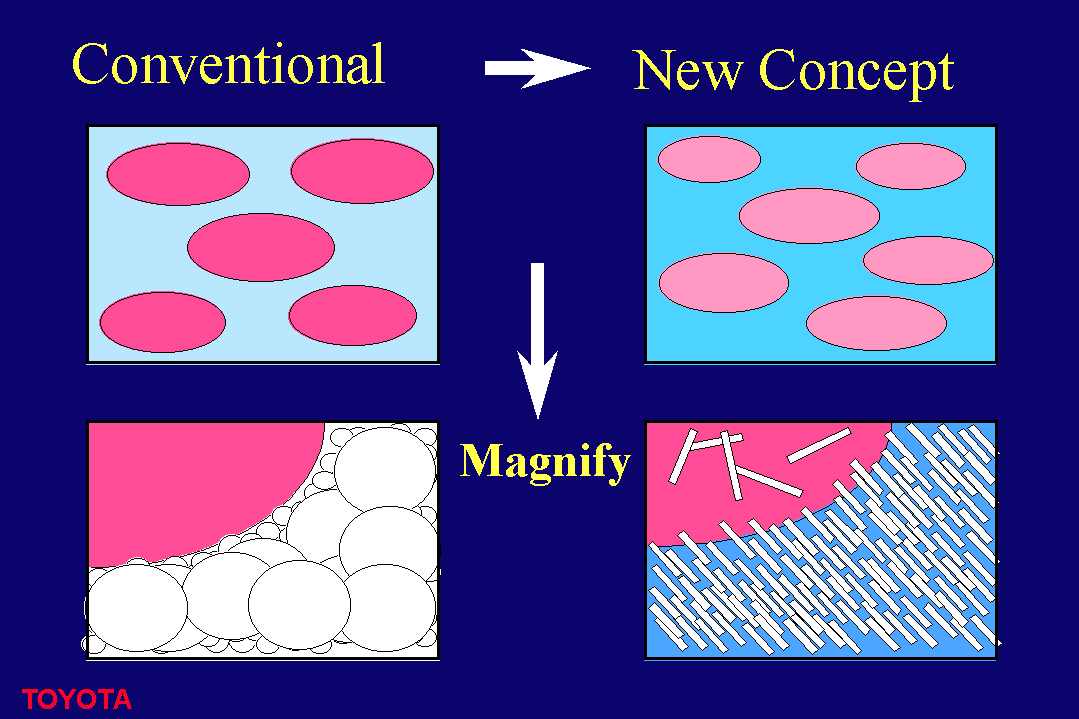 |
We have tried to establish a new theory based on a reverse concept for the clarification of the reason.
It is thought that PP is the matrix of TPO, and EPR forms the domain so far, but I proposed that PP forms the domain in the matrix of EPR.
It can be explained the reason why CLTE of PP/EPR is lower than those of the alloy materials of PP with engineering plastics.
In other words, EPR of the matrix is stretched in the injection molding process and residual strain.
Since it works as contraction force after heating, CLTE of the material becomes low,is remained in the molded material.
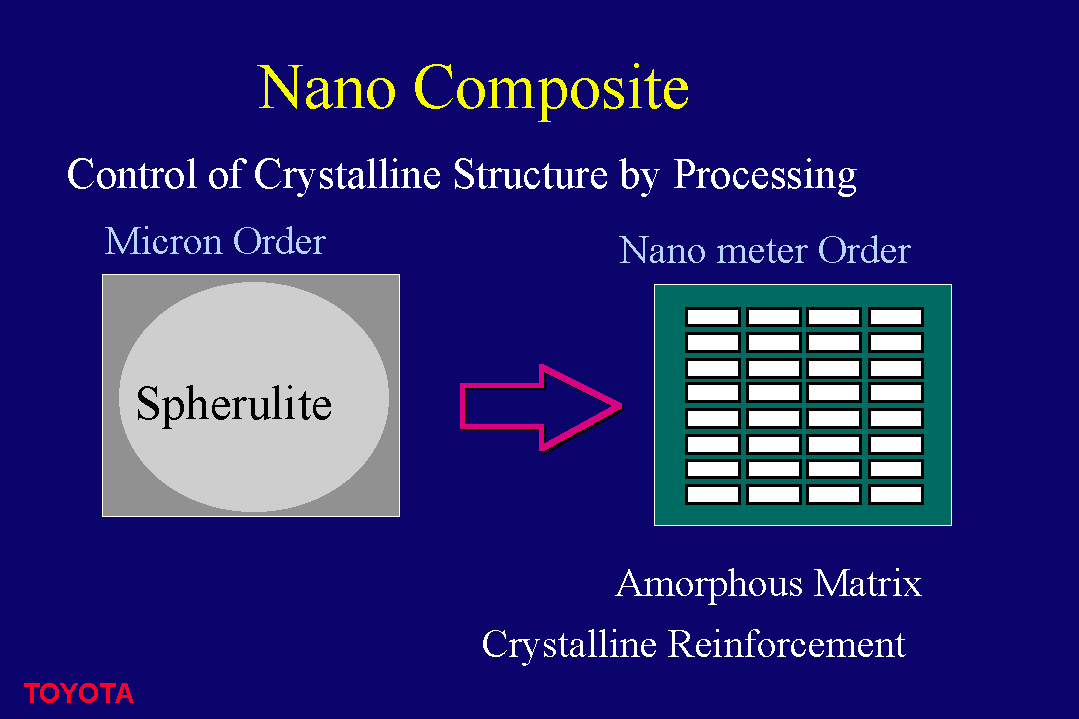 |
Since the figure in the last slide is just conceptual, I will explain the basic philosophy of the reversed structure of the matrix and the domain using this slide.
Actually, it is not correct that the matrix is converted into the domain, but the component of the matrix is changed from resin to elastomer.
As shown in this slide, rubber domain is the same as the conventional structure.
Figures in the lower portion of this slide are magnified ones and PP forms spherulite in the conventional resin matrix.
But PP is thought to be dispersed as fine crystals in the elastomer matrix through our new concept.
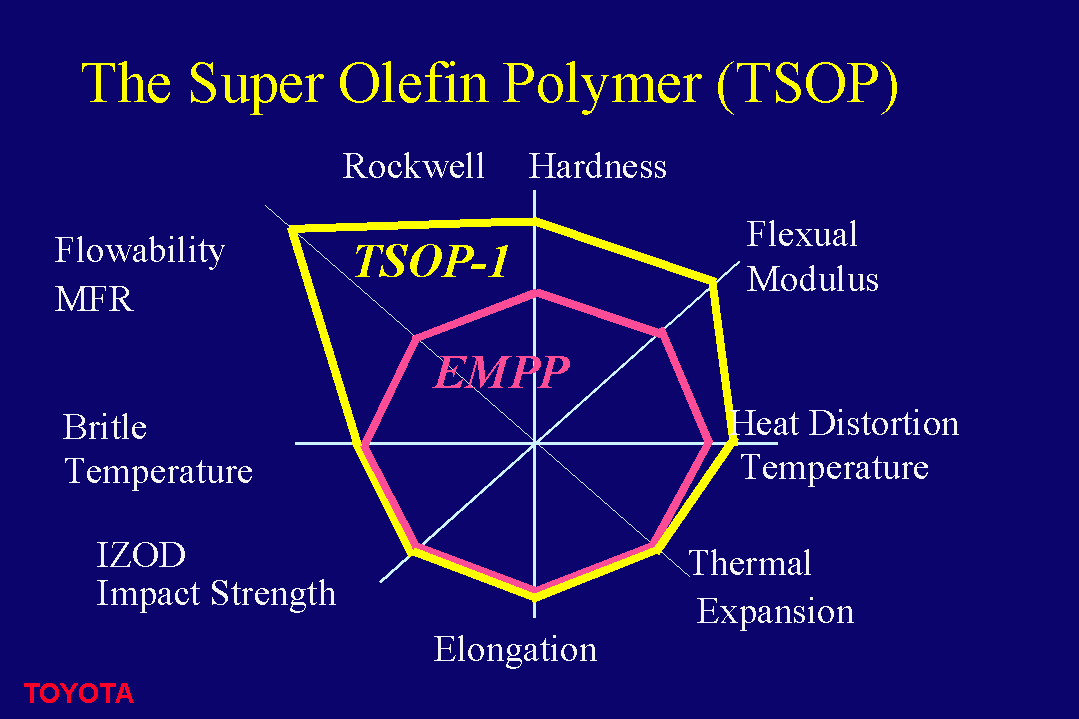 |
This slide shows the performance of the newly developed material based on the elastomer matrix concept.
By the fine dispersion of PP with high crystalinity and low molecular weight in the EPR matrix, hardness, rigidity and flowability can be improved drastically while retaining its advantage of the conventional TPO.
As it is a generation of the polymer with the superior properties which the conventional materials do not have, we named it"The Super Olefin Polymer (TSOP)" and used it for the bumper application.
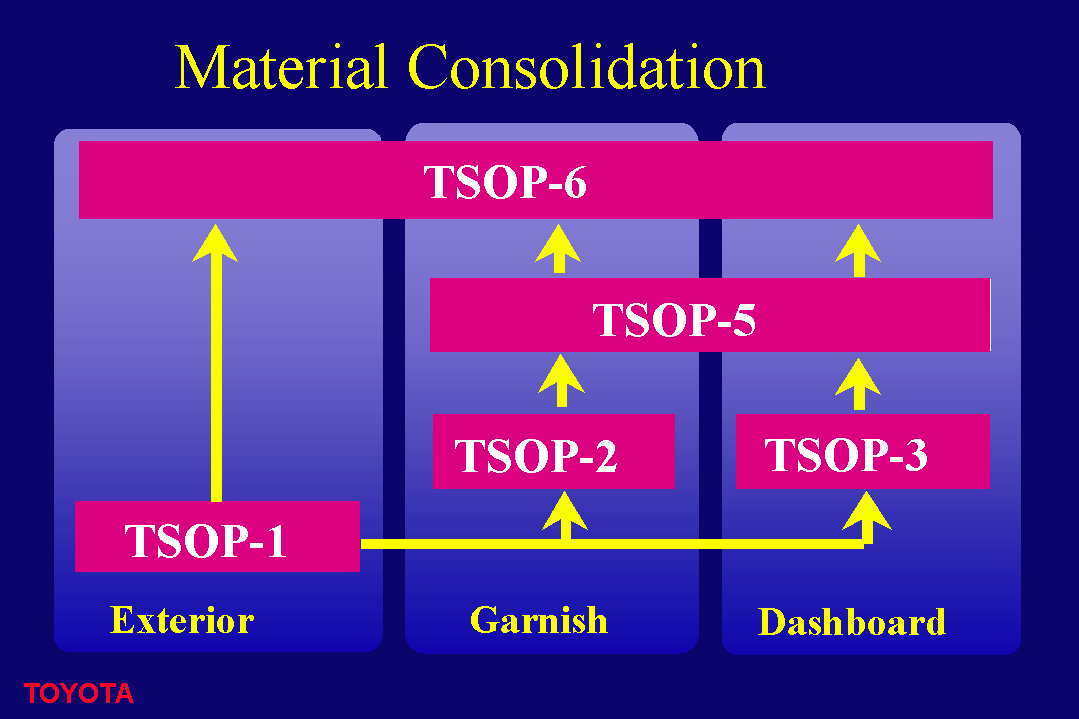 |
Since the significant improvement was able to be achieved by the elastomer matrix concept, we intended to take this technology into our plan of the material consolidation.
By the control of the amounts of the elastomer and the talc of TSOP-1 developed for bumpers, the many kinds of materials for automotive interior parts were able to be consolidated to two materials, that is, TSOP-2 and TSOP-3.
Then, we have challenged the development of the single consolidation material with the properties combining those of these two materials for automotive interior applications.
Moreover, we set the development of a dreamlike material, TSOP-6 which makes the material consolidation for both exterior and interior parts possible for the ultimate goal.
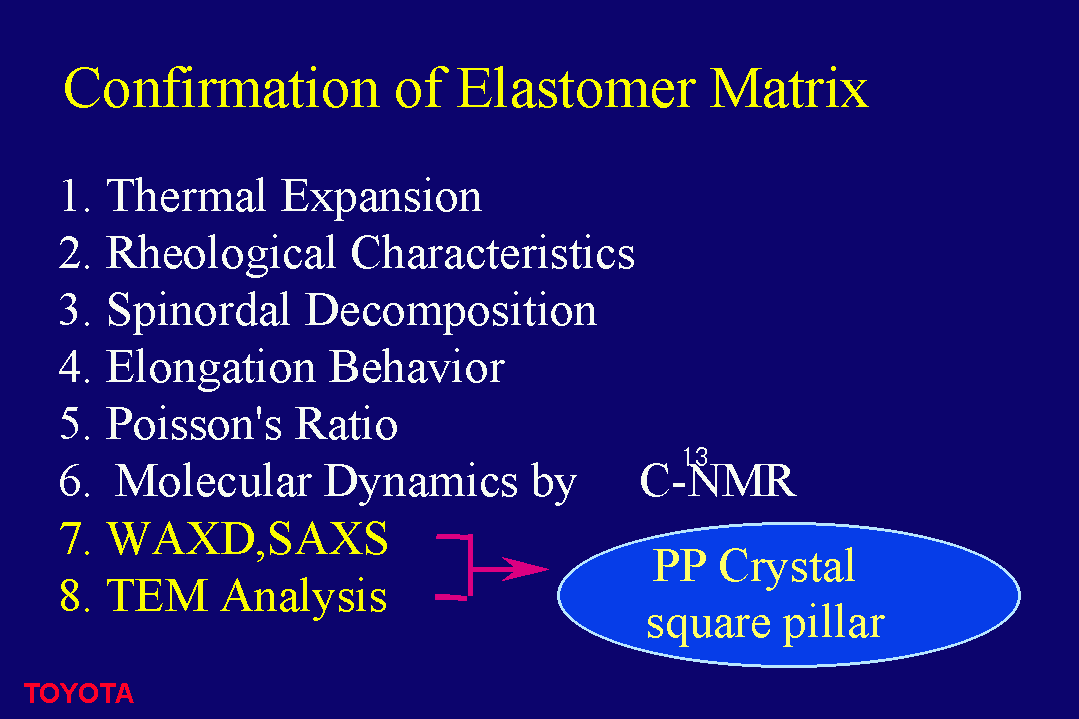 |
For the material development, we have tried to analyze TSOP material to confirm that TSOP is the real elastomer matrix polymer and what crystalline structure is formed.
As the results of analysis using techniques reaching the limit at present as shown in this slide, we can confirm that TSOP is the elastomer matrix polymer.
Further, from the results of TEM observations and X-ray study, it is found that TSOP has a completely new crystalline structure, that is aligned square pillar-shape structure.
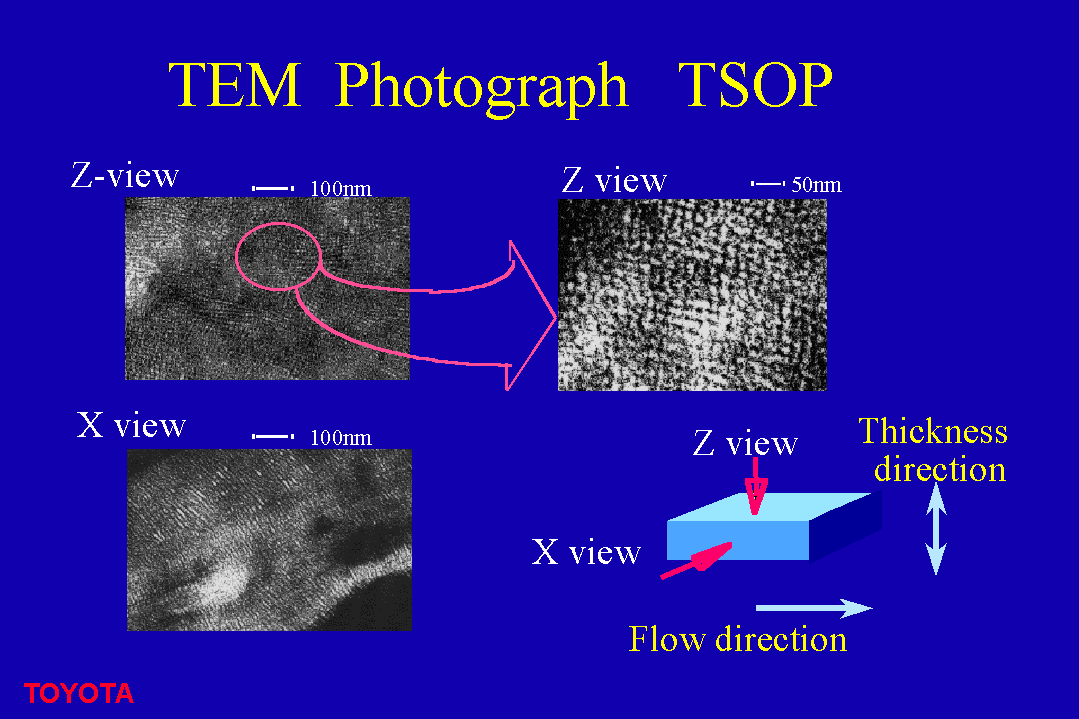 |
This slide shows photographs of transmission electron microscope observations of specimens cut with considering thickness and flow directions of injection molding from a bumper.
You can see the striped pattern in black and white from X-view, the cross-sectional direction of thickness, and the mesh-like pattern from Z-view, the thickness direction, that is the direction perpendicular to the surface.
The photograph in the right and upper portion of the slide shows the magnified one and the lattice pattern is observed.
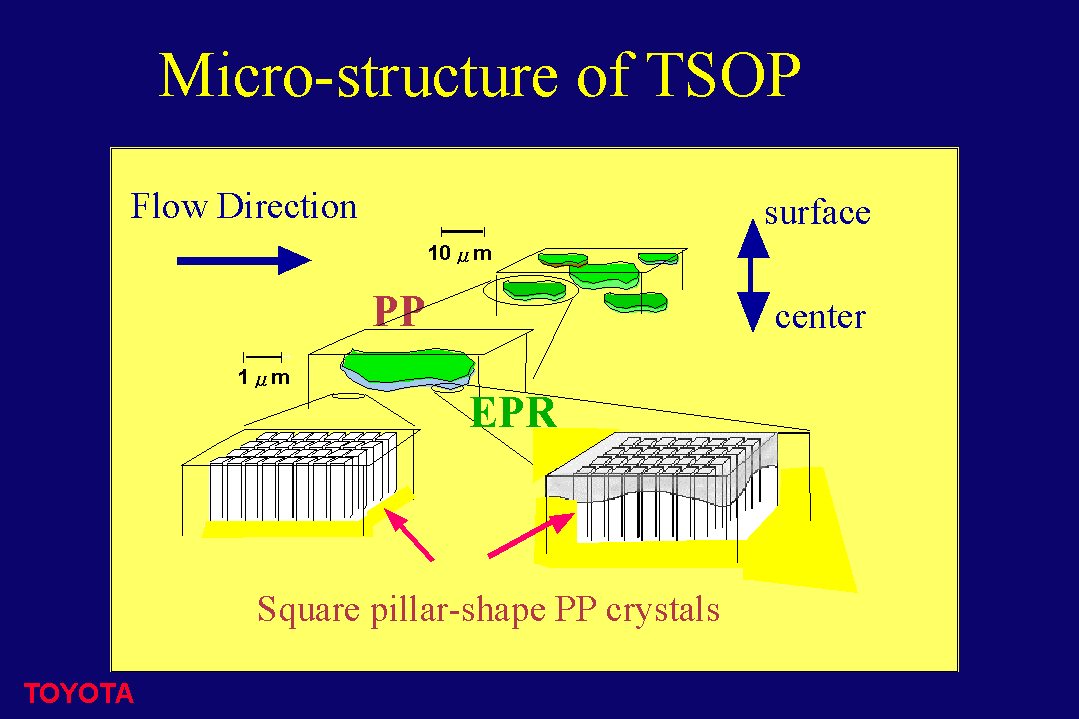 |
From the results of TEM photographs, the structure of TSOP is understood as follows.
Rubber domains are stretched and in the injection molding process and flat-shaped.
And PP crystals are oriented as a square pillar-shape crystal in the elastomer matrix.
This structure was confirmed from the results of wide angle X-ray diffraction and small angle X-ray scattering studies.
This structure can draw TSOP's high performance which is not attained absolutely by the conventional material technology.
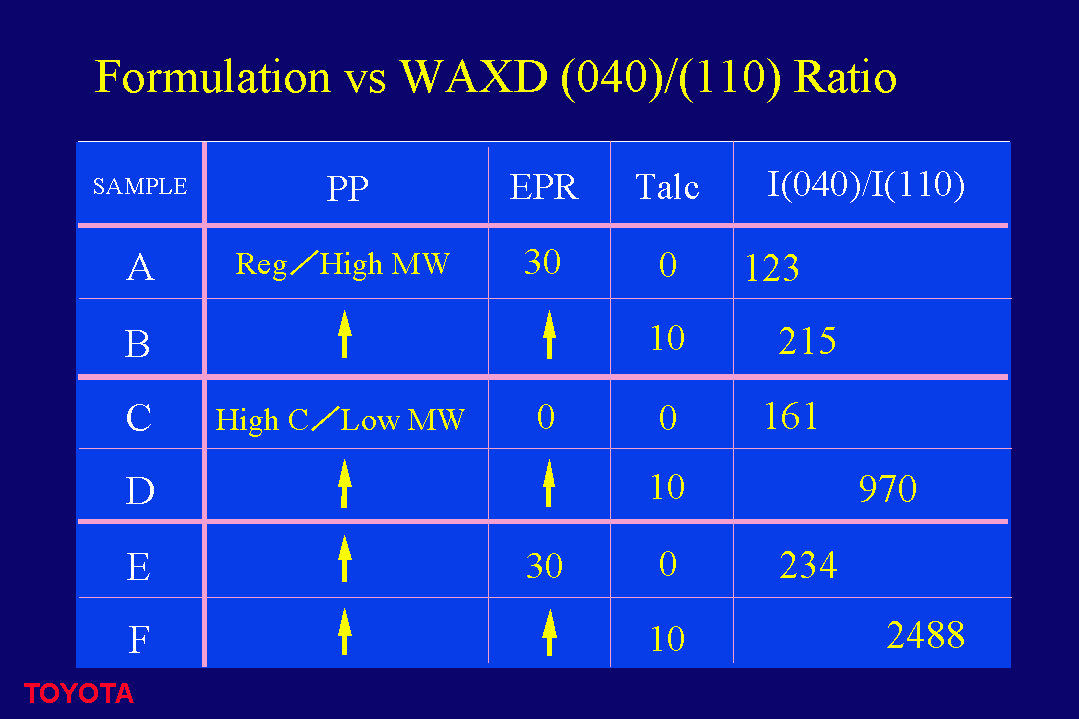 |
Next ,we have investigated in what situation the aligned square pillar-shape crystalline structures can be formed.
The level of formation of the aligned square pillar-shape crystals was obtained from the ratio of the crystal's a-axial and b-axial peak strength measured by wide angle X-ray diffraction.
As a result , the factors for the crystalline formation were high propylene content EPR, high crystallinity PP, and talc, as listed in this table.
The high propylene content EPR establishes an elastomer matrix condition, where the PP crystals can be dispersed finely.
Further more, when the low molecular weight and high crystallinity PP is introduced, the formation of the square pillar-shape crystals is accelerated.
Finally, the talc aligns the direction of the crystals.
With these synergy effects, the peak strength ratio of this material becomes more than 10 times that of the conventional TPO with the same material composition, hence this fact is an evidence of the formation of the aligned square pillar-shape crystalline structures .
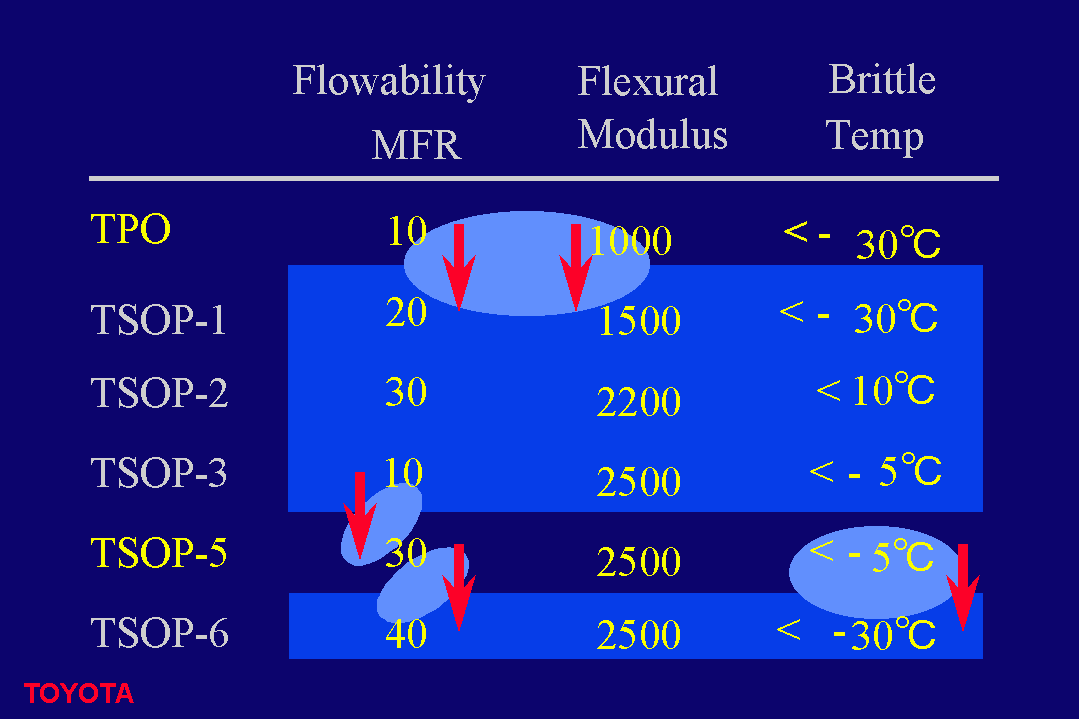 |
As the method for how to increase the aligned square pillar-shape crystalline structures was solved, we have started the development of a consolidation material for automotive interior parts.
As a result, we have succeeded in developing TSOP-5, which has both TSOP-2 and TSOP-3 performances. As like the significant improvement of the performance of the new material TSOP-1 generated based on the elastomer matrix concept comparing to the conventional TPO for bumpers was attained, through the formation control of the aligned square pillar-shape crystalline structures, we have achieved further significant improvement of the performance of TSOP-5.
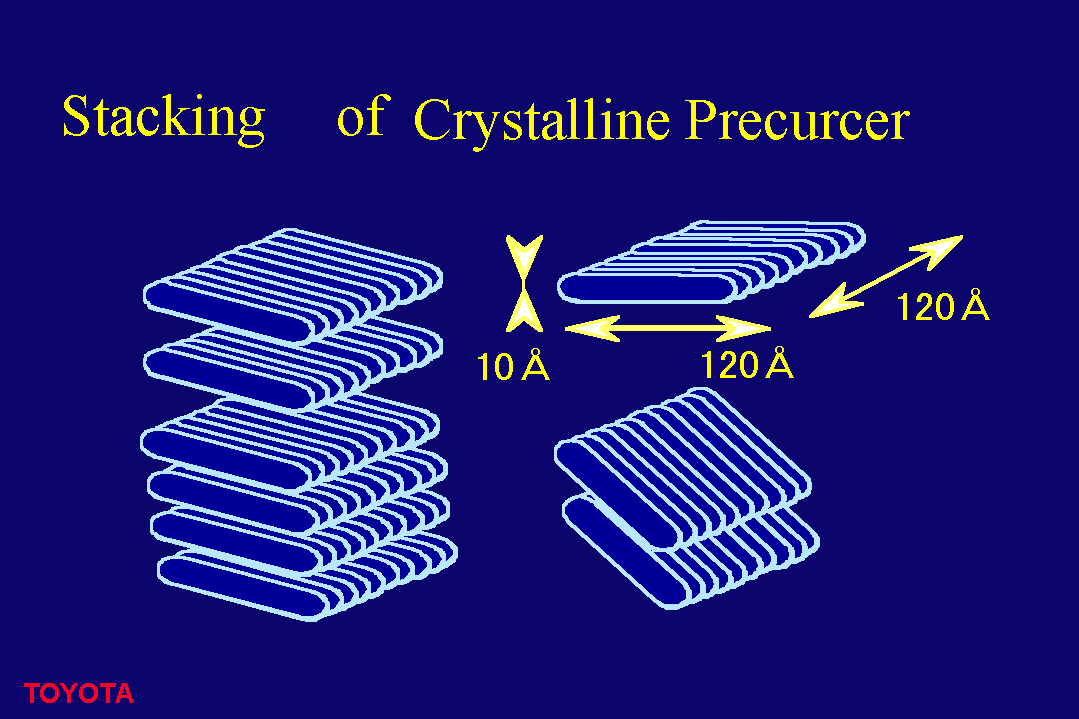 |
It is very mysterious, how such a structure can be formed.
In the conventional theory, the crystals form in the manner that the random polymer chain folds epitaxially at solidification process, but with this theory , it is impossible to explain the aligned square pillar-shape crystalline structures .
Therefore , we have established a hypothesis which would be a tool to develop a much higher performance polymer.
The hypothesis is that a single polymer chain folds and forms a plate-shape crystalline precursor, which exists in fluctuating in the melt.
Fluctuating square pillar-shape crystalline precursor can be formed by stacking of these plates, then the aligned square pillar-shape crystalline structure is formed by cooling and solidification.
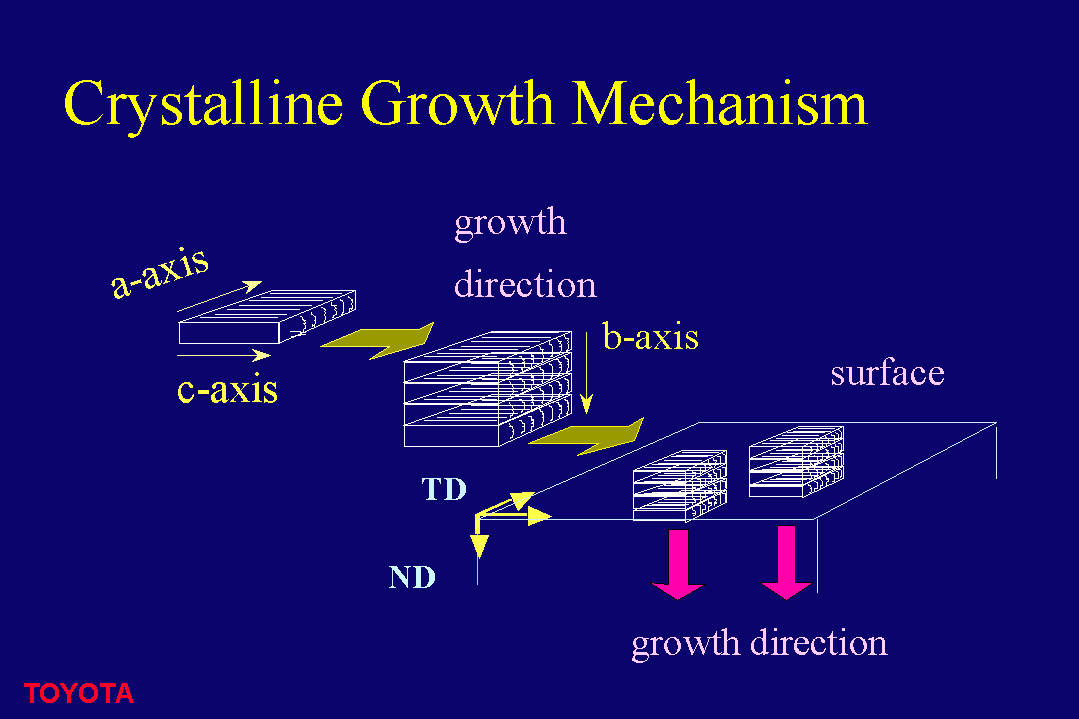 |
Our theory is as follows.
Highly isotactic polypropylene takes the form of this crystalline plate unit which is of a single polymer chain, just after polymerization.
During melting and compounding of the material, these fluctuating plate units attract each other by van der Waals force and stack up.
During injection molding, the material solidifies maintaining its structure as it is cooled down, and forms the aligned square pillar-shape crystalline structure.
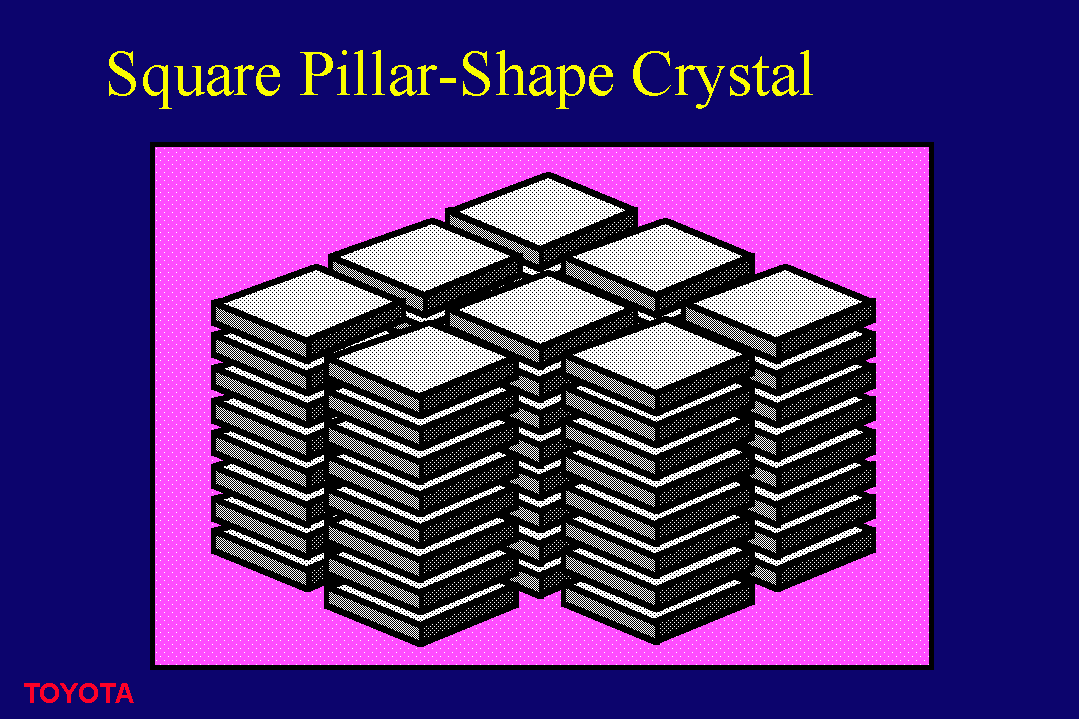 |
This is an illustration of the image of an ultimate aligned square pillar-shape crystalline structure formed by the stack of fluctuating crystalline precursors.
Amorphous PP and EPR elastomer matrix exist among the crystalline pillars.
EPR plasticizes and toughens the PP amorphous.
PP amorphous works effectively as tie-chains.
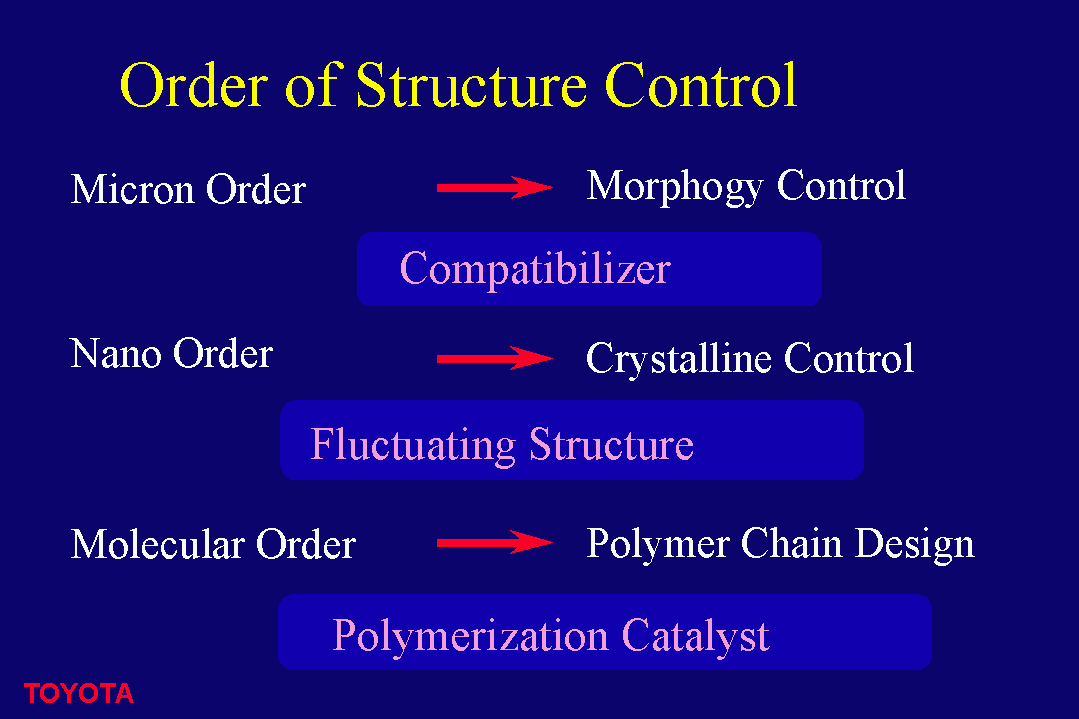 |
We are currently challenging to develop a consolidation material for both interior and exterior applications.
We have already established the technique to control the morphology at micron level.
The technology to control the crystalline formation at nano meter level is also within our hands.
I strongly believe that the clarification of fluctuating behavior of crystalline precursor in the melting state is the key technology for that.
I think it depends on the precise control of polymer chain structure at the stage of polymerization for the realization of the ideal fluctuating state.
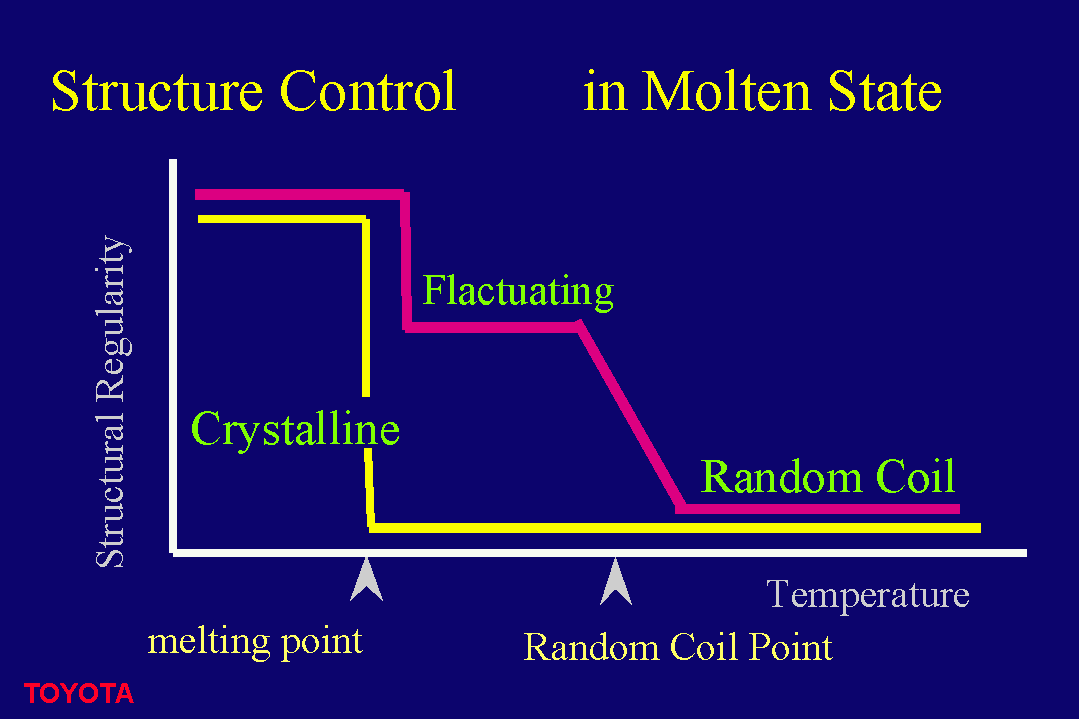 |
This chart indicates our way of thinking.
The conventional theory indicates that"the crystal dissolves and becomes a random coil at the temperature higher than melting point."
Our hypothesis is that "in case of highly isotactic polymers, if the temperature range is such that van der Waals force can still be effective even at the temperature higher than melting point, the fluctuating state exists, and if the temperature exceeds fur above the melting point, the polymer becomes random coil"
The structure memory of TSOP in the solid state has been confirmed at the temperature range between its melting point and 100 degree C above the melting point, and I believe the existence of the random coil point.
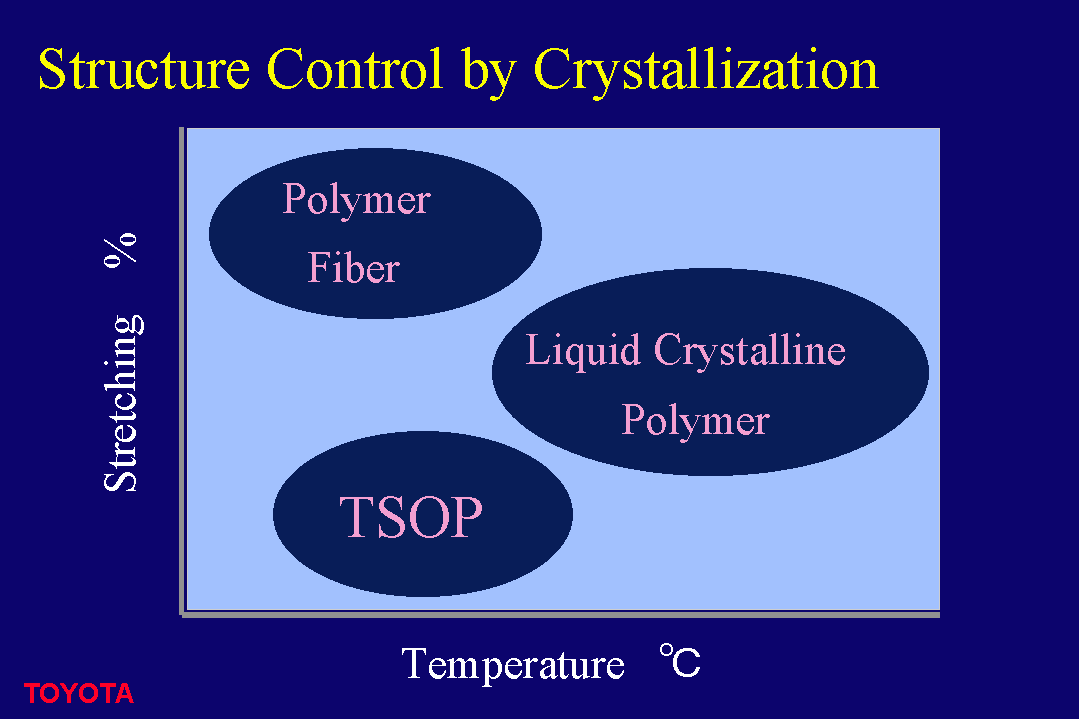 |
This slide shows the area where the fluctuating structure in the melting state appears.
The melted fluctuating structure of liquid crystalline polymers are already a common sense.
Synthetic fibers has a very small area of orientation.
The fluctuating structure of TSOP in the melting state is the similar phenomenon to those.
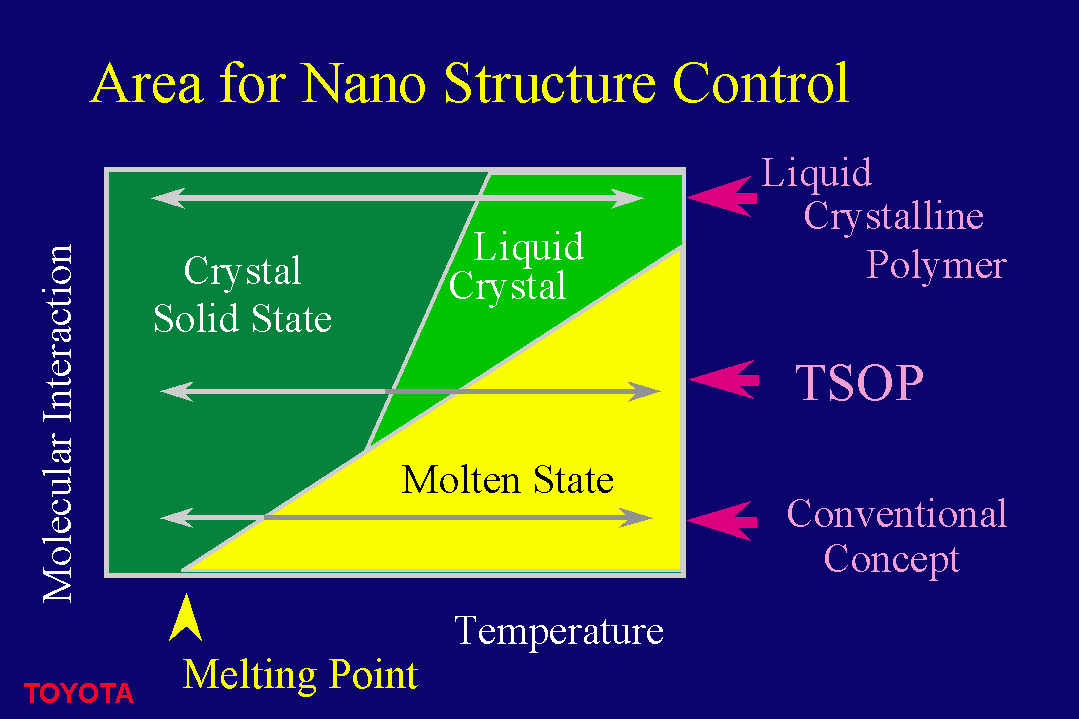 |
This diagram shows the relation between the inter molecular force and the temperature.
The bottom horizontal line indicates the case of crystalline polymers based on the conventional concept.
With the melt temperature as a turning point, the material crystallizes in the solid state, and the crystal becomes random coil in the melting state.
On the other hand, liquid crystalline polymers are shown by the horizontal line at the top, similarly with the melting temperature as a turning point, it crystallizes in the solid state, and it becomes liquid crystal in the melting state.
The center line indicates the case of TSOP where it crystallizes when solid, and when melted, it shows the liquid crystalline state first, in another words , fluctuating state in the melting state , and becomes random coil in an elevated temperature.
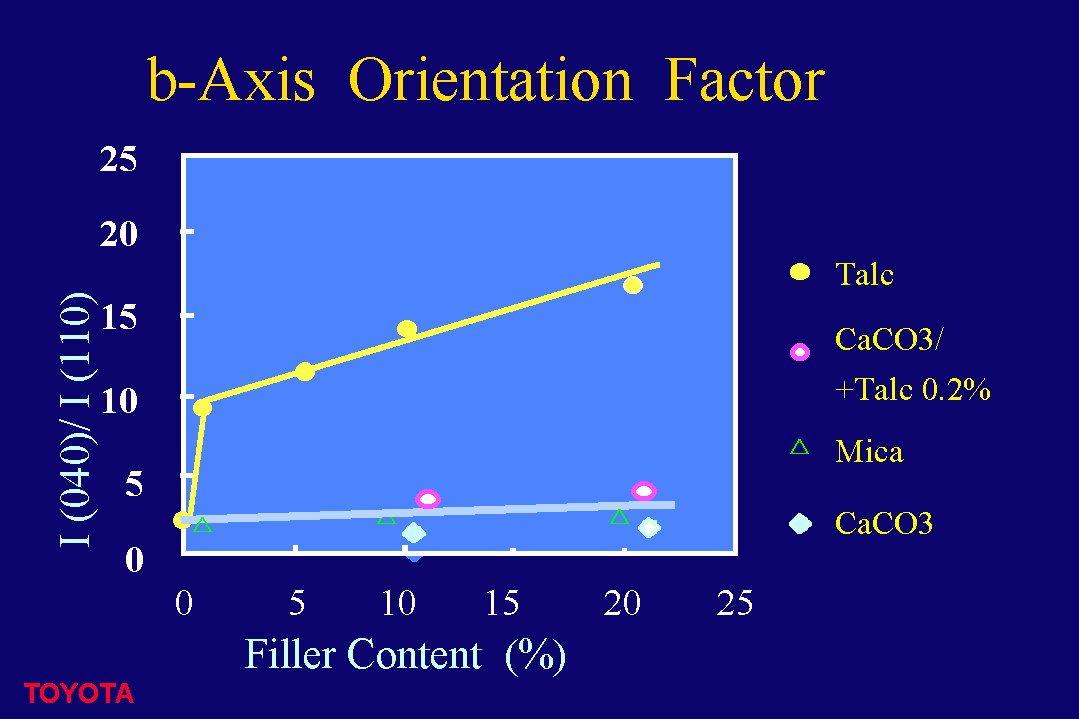 |
This chart shows the WAXD peak strength ratio as an index of b-axial orientation of PP crystals previously mentioned.
Highly isotactic PP shows the b-axial orientation even without fillers as it has the elastomer matrix structure.
The peak strength ratio increases as talc is added, increasing rapidly at zero point four percent content.
This can be understood that PP crystals and talc interact with each other.
Why does a small amount addition of talc increase the b-axial orientation of PP crystals in such way?
Following is my theory.
The stack up of the crystalline plate units occurs in a random direction without the talc, but with talc, because the crystalline structure of the talc is very similar to the ac- plane of the highly isotactic PP crystalline plate, the plates are adsorbed on the cleavage plane of talc by van der Waals force, therefore the direction of orientation is unified.
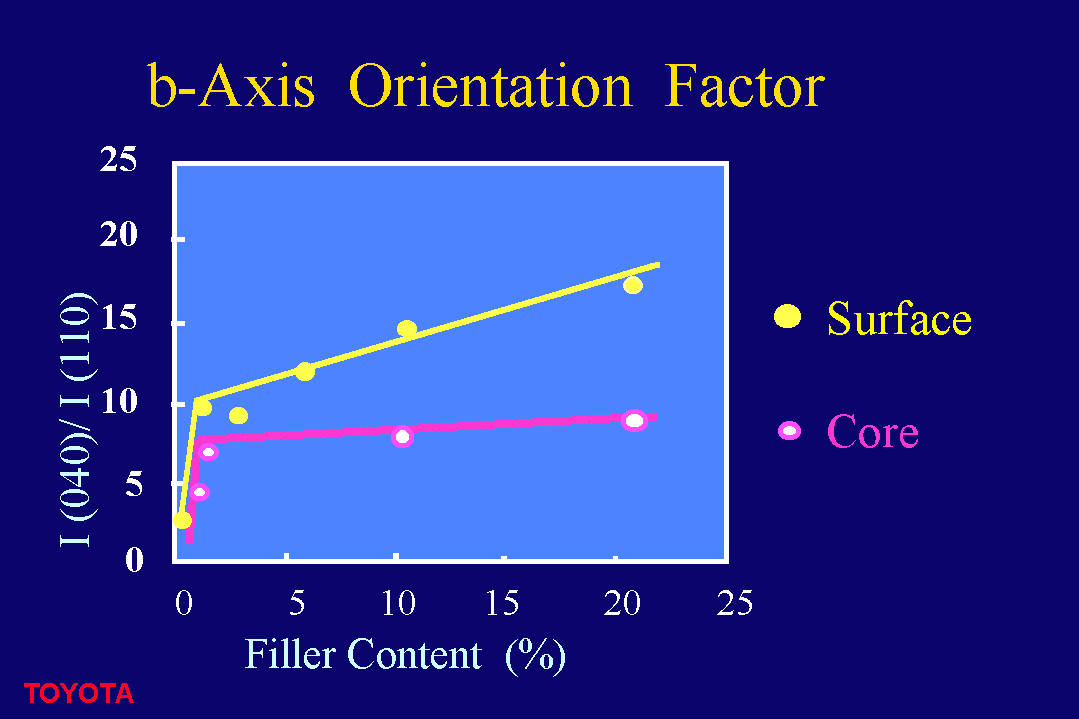 |
This chart is a comparison of the index of b-axial orientation of PP crystals of the surface and the core positions of an injection molded specimen.
It can been seen that the peak strength is stronger at the surface and increases with the talc addition, but the core seems not to be affected as much.
The peak strength ratio increases by the presence of talc of zero point four percent, in other words, by the adsorption of the ac- plane of the highly isotactic PP crystalline plate on the cleavage plane of talc, and as the talc orients toward the flow direction but not in parallel each other, there is no effect on b-axial orientation of PP crystals with addition of large amount of talc.
On the other hand, the talc at the part surface is oriented strongly by the tool surface during injection molding, and b-axial orientation of PP crystalline plate adsorbed on the talc surface increases with the amount of the talc.
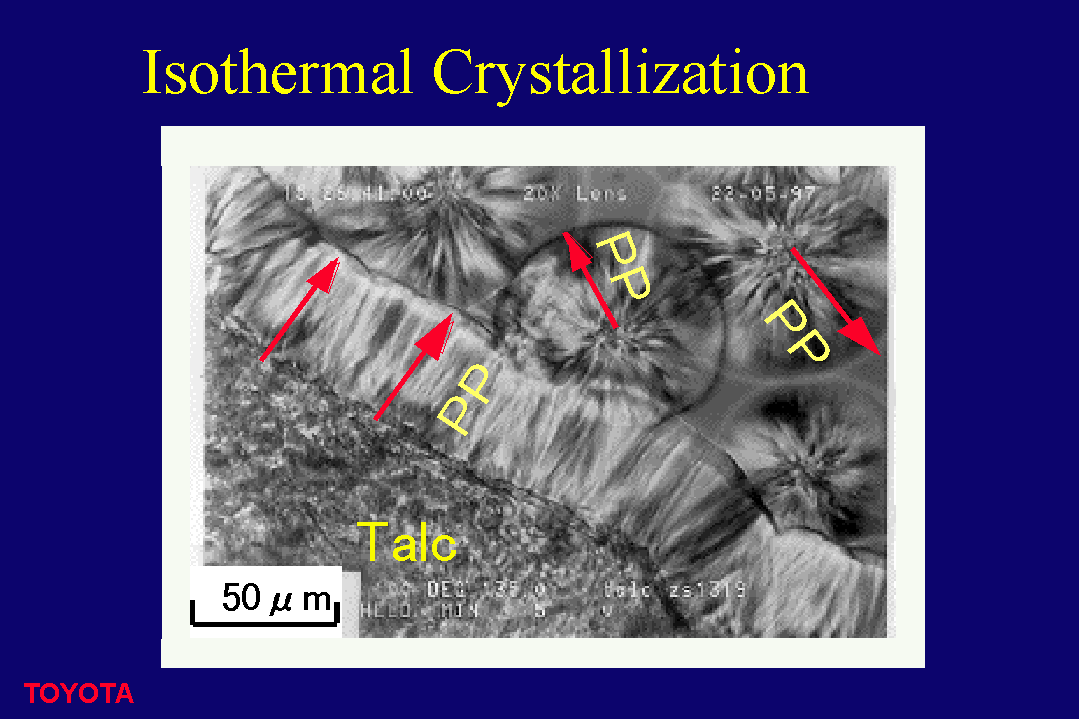 |
Next, we have confirmed experimentally that the absorption of the ac-plane of the highly isotactic PP crystalline plate on the cleavage plane of the talc actually occurs.
This is a picture of TSOP crystallized by the isothermal condition with the presence of the talc.
The crystals grow in one direction near the talc surface, while in other general areas, spherulites grow, as you can see.
This fact supports my hypothesis.
The stacking of fluctuating crystalline plates in the melting state results in the phenomenon shown in this picture.
Further more, from the X-ray diffraction analysis results, the crystalline growth direction was in the a-axis for both transcrystals and spherulites.
This is the same result that the spherulite growth direction of the conventional PP crystal is in the a-axis.
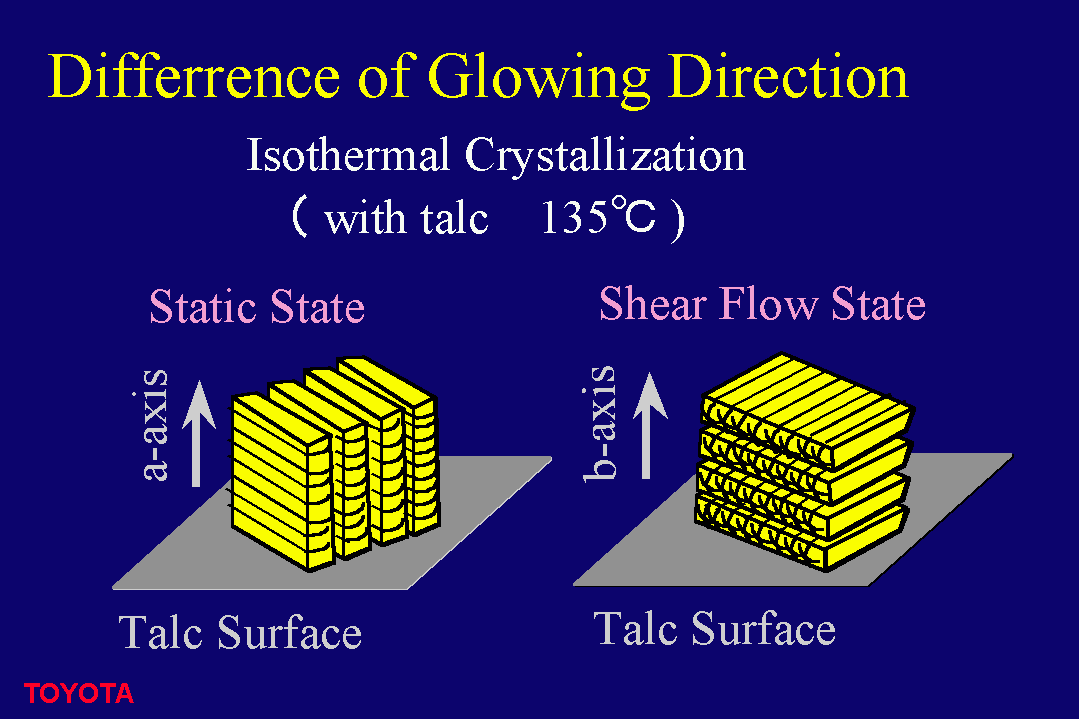 |
These results support our hypothesis and we believe that discovering of the actual mechanism, is the key to the new high performance material development.
A similar experiment was conducted under shear condition for TSOP, compounded with talc and elastomer.
As a result of X-ray diffraction analysis, it was observed that there is no spherulite and the direction of crystalline growth was the b-axis.
It can be estimated that the shape factor of the fluctuating crystalline plate has come to effect by the shear flow.
Isothermal crystallization under weak shear force by rotating a cone plate slowly was intended for this experiment ,and we can obtain the same result of the crystalline growth direction in the case of injection molding.
I think that planner structure of the fluctuating crystalline plate in the melting state tends to orient to the direction which that crystalline plate flows easily.
The crystalline lattice structures of the ac-plane and the bc-plane of the PP crystal are very similar to that of the talc's cleavage plane.
But since absorption force of bc-plane to the talc surface is just a little stronger than the ac-plane, the crystalline growth is in the a-axial direction in a static condition.
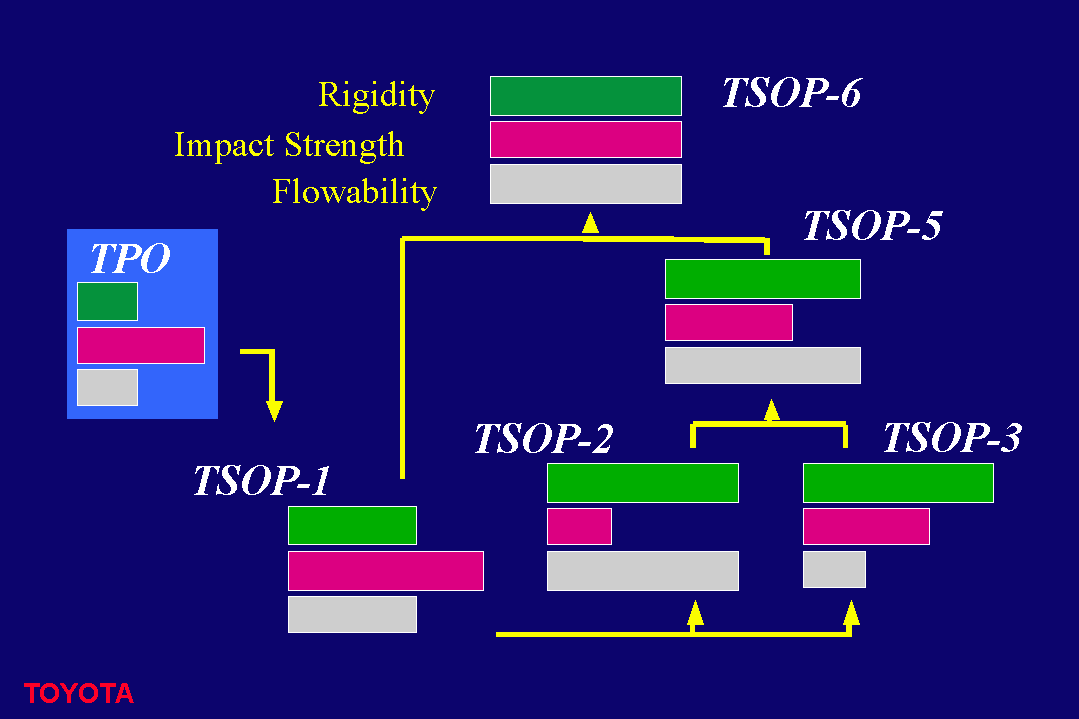 |
In such step, we have continued to evolve the TSOP.
We are currently very close to the completion of the TSOP-6 development which is an ultimate target to consolidate materials for both automotive interior and exterior applications.
As explained, we have utilized our hypothesis as a tool to achieve our goal.
If the hypothesis was completely wrong, we could not have done such a development.
It was , in the past, not possible for a thermo plastic material to satisfy all of high modulus, high impact, and high flowability.
Please compare the performance of this TSOP-6 to the TPO on the left hand.
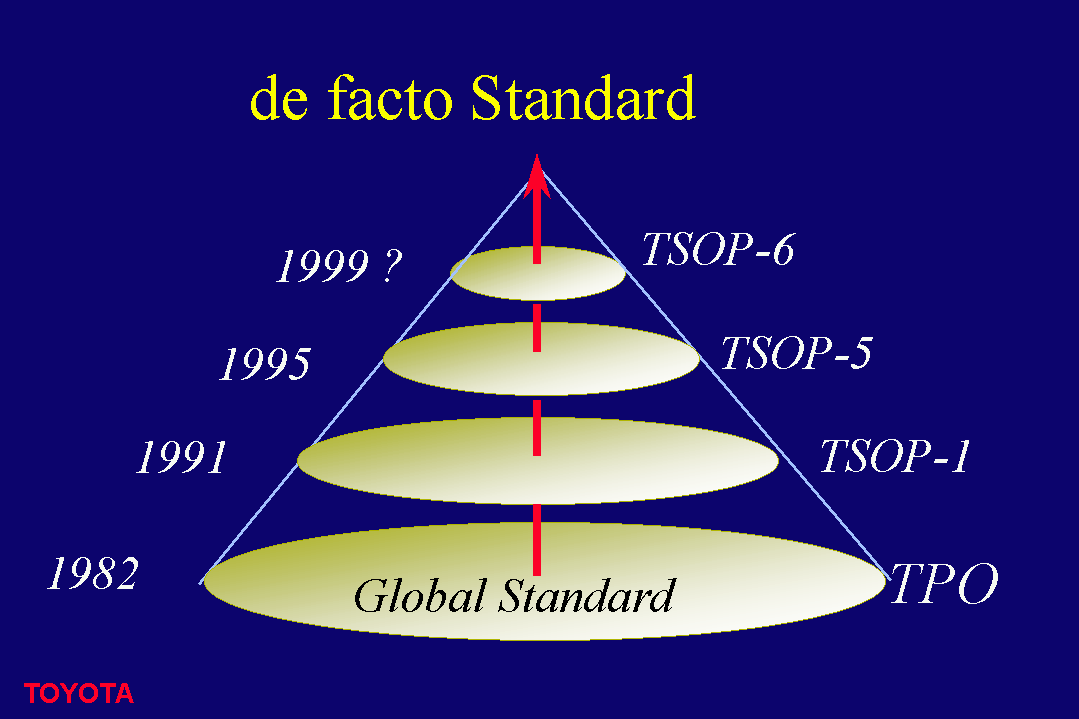 |
Finally, we have attempted to develop the high performance materials based on the TPO, as a global standard material for automotive applications, without altering its formulation and by changing it to the elastomer matrix polymer.
We have got the next generation of the material by fully utilizing the crystal formation control technology to create the nano composite.
It is obtained by the highly controlled polymer processing technology.
I hope that this kind of study will grow further to be recognized and evolve into even more new technology.
If you have any objections, I would like to discuss later independently as I don't have enough time here.
This is the end of my talk, and thank you for your kind attention.